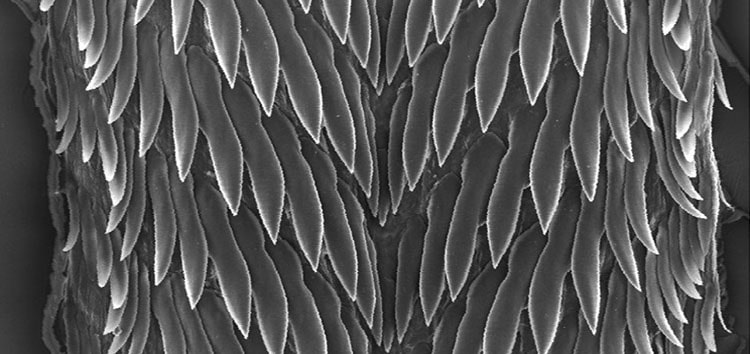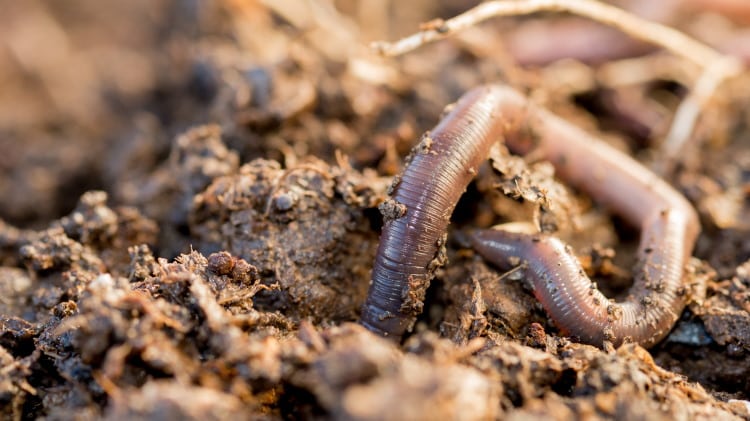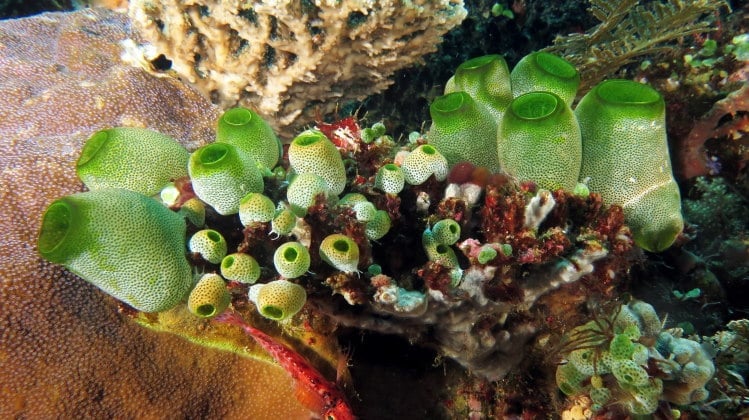Gastropod Predators & Defenses: What Animals Eat Snails?
Gastropod Predators & Defenses: What Animals Eat Snails?
Gastropod predators are everywhere, at least that must be how it looks when you are a snail or a slug. Who then is it that is out there eating all these helpless snails. For some species, one answer is of course people. Human beings consume huge numbers of gastropods from all three of their habitats; terrestrial, freshwater and marine.
What animals eat snails?
Why would anyone, or anything, eat slimy slugs and snails is a question many people may ask. The answer is not that they are delicious, although a large number of people experienced this as true; this is because most animals are far more practical in their food choices than we humans are.
For all the myriad other creatures that eat slugs and snails, the answer is that they are highly nutritious. Snails contain more protein than many species of fish and loads of other nutrients including vitamin B12. However, slugs and snails have even more going for them than mere nutritional goodness. They come in relatively small. often bite-sized packages, they are often numerous in whatever habitat you live in and they are usually slow and easy to catch. What more could a hungry predator ask for?
What else eats gastropods then naturally depends on where they, the being-eaten gastropods, live. In terrestrial habitats slugs and snails are food for both creatures larger and smaller than themselves. Predators of land snails include beetles and their larvae, millipedes, flies and their larvae, mites, nematodes, spiders, shrews, mice, squirrels, and other small mammals.
Salamanders, toads and turtles as well as many ground foraging birds are also happy to eat large numbers of gastropods. In aquatic habitats snails are readily devoured by birds, reptiles, amphibians and fish as well as by a host of marine invertebrates from Octopuses through annelid worms and starfish to other gastropods again. However, what may surprise you is that one of the most frequent gastropod predators in marine habitats, as well as less frequently in terrestrial habitats, are other gastropods.
Invertebrates As Gastropod Predators
Terrestrial Habitats
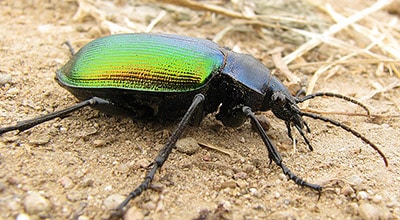
The ground beetles, (Coleoptera; Carabidae), and fireflies (Coleoptera; Lampyridae) are specialized gastropod predators and most species eat only terrestrial gastropods. Other full-time snail eaters include the beautiful family of flies Sciomyzidae (Diptera), commonly these are known as Marsh Flies, or, Snail Killling Flies. Sciomyzidae only feed on snails in their larval stage, the adults only drink nectar, but their larvae prey on both freshwater and terrestrial species of snails.
Despite what Bristowe believed in his wonderful book The Comity of Spiders 1941, snails are not always immune to attack from spiders. The New Zealand Funnel-web Spider (Porrhothele antipodiana) regularly kills and eats snails, it may spend many hours feeding off the body of the snail. Other spiders which are known to prey on snails include The Cobweb Spider Cryptachaea (Archaearanea) veruculata and Paraembolides boycei.
Other arachnids are also known to kill and eat snails, among the amazing Opilionids Ischyropsalis hellwigi is a species that has a definite taste for uncooked escargot.
Freshwater Habitats
In fresh water habitats, such as lakes and rivers crabs are the main invertebrate predators of snails. The freshwater Purple Matano Crab Syntripsa matannensis and the White-claw Sulewesi Crab Syntripsa flavichela are classed as molluscivores. Using their massive and powerful claws the break open the shells of snails and bivalves before eating the flesh.
Marine Habitats
In marine environments predation begins for many species as soon as the eggs are released into the water to become fertilized. These eggs, as well as the trochophore and veliger larvae float in the oceans in huge numbers. These pelagic stages of the gastropod lifestyle therefore become part of the zooplankton and are voraciously fed on by plankton feeders such has herring, sardines and anchovies (both various species), shad, silversides, sprats and menhaden.
One of the main groups of predators for adult marine gastropods are starfish, especially the genus Pisaster has been studied. Apart form starfish other predators that regularly feed on marine gastropods include larger gastropods, conches in particular, and octopuses.
Predation of gastropods by octopuses has been studied for the Common Octopus Octopus vulgaris. The octopus, having selected its prey drills a hole into the preys shell, then excretes saliva into the borehole and later uses its radula again to extract the flesh.
Various species of whelks, which are predatory gastropods, also feed by drilling a hole into their prey’s shell. Like the Common Octopus they also feed on Bivalves and other sedentary Molluscs, as well as their fellow marine snails
The Florida stone crabs (Menippe mercenaria) feeds on a variety of molluscs including marine snails. Crabs are also important snail predators in other marine habitats, from the sea shore to deep ocean hydrothermal vents.
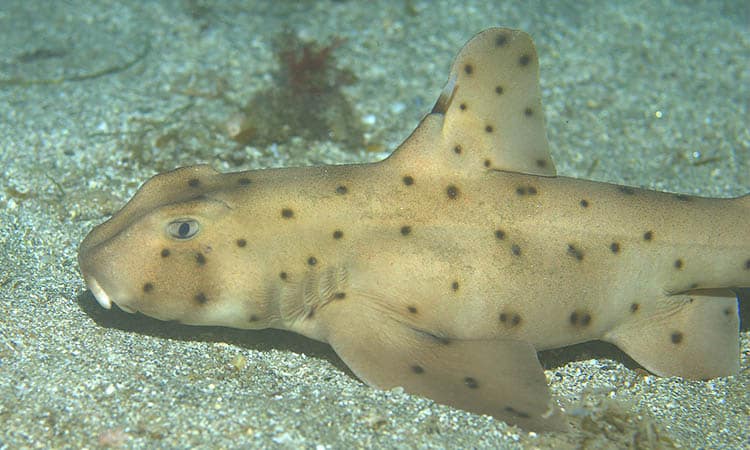
Fish As Gastropod Predators
A large number of fish will feed on snails and some species seem to really love eating them. Various species of rays, such as the beautiful Xingu River stingray (Potamotrygon leopoldi) love to eat snails. Like all durophagous fish, they have special adaptations of their teeth and jay muscles to allow them to deal with such hard shelled animals.
Marine Habitats
In marine habitats few species seem to be snail specialists. However a number of species regularly include snails in their diet, these include Puffer Fish such as Porcupine Puffer Fish, Dog-faced Puffer Fish and various Wrasses. Two circumtropical spiny puffer species, Diodon holacanthus and Diodon hystrix, are considered to be important predators on gastropods, including snails and were used in experiments of snail defenses against predation by shell crushing fish.
Many species of rays, especially those in the family Myliobatidae, prey on gastropods using strong teeth to crush the shells. There are also a few species of sharks such as Horn Sharks that will feed on limpets and some Chimeras (Holocephali) will happily include gastropods in their daily diet. Scientists believe that the heavy, often spiny shells of marine gastropods evolved directly in response to predation by rays sharks and crabs.
Freshwater Habitats
There are quite a few species of freshwater fish that are connoisseurs of snails, these include species of: Loaches, Gouramis, Catfish, Sharks and Puffer Fish. Particular species that will eat gastropods also include: Tench (Tinca tinca), Roach (Rutilus rutilus). The Lungfish, Protopterus annectens, and some species of the families Mochokidae and Tetraodontidae,
The Black Carp Mylopharyngodon piceus has been used as a biological control agent against freshwater snails in Israel.
The appropriately named Shellcracker Sunfish (Lepomis microlophus), is an avid devourer of freshwater snails. There are also many cichlids such as Alluaud’s Haplo (Astatoreochromis alluaudi) and Green Beam (Sargochromis mellandi) from Southern Africa, Trematocranus placodon and several other species of cichlids from Lake Malawi as well as some 20 assorted species of the genus Haplochromis from Lake Victoria that regularly eat snails.
Finally, Aquarists often keep small species of Botia in their aquariums because they do such a good job of controlling snails. Larger species of Botia also feed avidly on snails. Another small fish that is happy to eat snails are species of Gambusia. Generally well known for feeding on mosquito larvae, research has shown that at least six different species happily dine on snails as well.
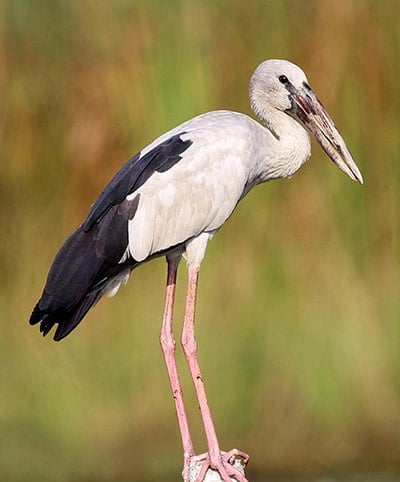
Birds As Gastopod Predators
Many species of birds are happy to enjoy snails for supper. Those birds best known for their taste in escargot include, ducks, corvids, herons, egrets, storks, raptors, thrushes and owls. While many birds feed on snails when they can do so easily only a few have become specialized gastropodivores. Most birds take only snails that are small enough for them to eat whole, or for them crack the shells with their beaks. For many birds snails are an important dietary supplement in the run-up to the breeding season as they offer, not only a good source protein but also, if eaten whole, calcium, which they need to make their shells.
Ducks, including particularly mallards (Anas platyrhyncos) (note that Indian Runner Ducks are a subspecies of Anas platyrhynchos) , wood ducks (Aix sponsa) and ruddy ducks (Oxyura jamaicensis), all thoroughly enjoy a good breakfast, lunch and supper of snails. Breeds of Anas platyrhynchos are such ardent gastropod predators that nowadays they are used as an environmentally friendly method of controlling snails from places as far apart as South African Vineyards to Asian rice paddies. Here is a lovely video of the duck army employed by the Vergenoegd Low Wine Estate in South Africa.
Birds That Specialize in Snail Suppers
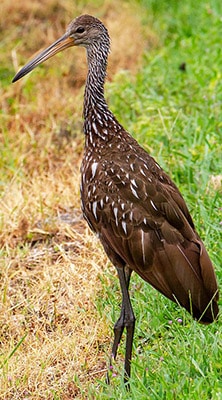
Most famous of the specialist gastropodivores is the European Song Thrush (Turdus philomelos) because of its habit of using a prominent stone as an anvil to smash large snails on. However in South America the Snail Kite (Rostrhamus sociabilis) feeds almost exclusively on Apple Snails (Pomacea sp.). A third group of avian snail specialist are the open billed storks.
The genus Anastomus seems to have evolved in the old world as specialist gastropod predators focusing on fresh water snails of the genus Pila, (African and Asian Apple Snails). However recent studies have shown that Anastomus oscitans, the Asian Open-billed Stork, has taken to feeding on the invasive South American Apple Snails of the genus Pomacea. Unfortunately they tend to feed preferentially on the largest specimens, leaving the young alone. While this is a good strategy for them, as it ensures an ongoing food supply, it makes them ineffective as a control agent for this highly invasive group of species.
As a brief aside, the gap in the bill of Open-bill storks does not allow them to crack open the snails shells, as many people suppose. Rather it causes the tips of their bills to be more directed towards each other, which presumably makes grasping the snails body easier. Open-bill Storks feed by using the tips of their bills to extract the snail’s body from its shell.
Finally, a rather unusual bird, because it is the only species in it family, the Aramidae, making in monotypic is the Limpkin (Aramus guarauna). This is a small to medium rail-like bird from America, that feeds almost entirely on apple snails.
Reptiles As Gastropod Predators
Many reptiles are happy to enjoy slugs and snails as part of a carnivorous diet focused on small invertebrates. This is particularly true of lizards in the skink family (Scincidae) such as the Australian Blue Tongue Lizards of the genus Tiliqua.
Other reptiles that like to munch down on snails (freshwater snails in this case) include Snapping Turtles. The larger species, such as Macrochelys temminckii include any snails they find in their diet when they are young and smaller than full adult size. Other carnivorous terrapins will also eat fresh water snails if they get the opportunity.
Some reptiles are more than adventitious snail eaters, they have become specialists, making snails, either terrestrial or freshwater the mainstay of their diet. In Australia, Hemisphaeriodon (Cyclodomorphus) gerrardii is commonly called the Pink Tongue, or Snail Eating Lizard.
Among the tortoises and turtles there are three dedicated gastropodivores from Asia in the genus Malayemys. The first two of these are the Malay Snail-eating Turtle and the Mekong Snail-eating Turtle. The third of the trio, the Khorat Snail-eating Turtle (Malayemys khoratensis), was only discovered in 2016 and soon found itself at the center of a taxonomic controversy. It seems two different scientists described the new species, giving it different names, at the same time. Their papers were published within days of each other. Subsequent investigation brought to light the murkier waters of small scale scientific publication.
Snakes as Gastropod Predators
Snakes that specialize in eating snails are more common, with at least 75 species known around the world. However as at least five of those were only discovered this decade there may be more waiting to be recognized. Snail eating snakes are usually small to medium sized by snake standards ranging from 30cm to 150 cms in length.
In Southern Asia, including Thailand and The Philippines, there are at least 15 snail eating specialists in the genus Pareas, such as The Keeled slug-eating Snake (Pareas carinatus), whereas in Africa you may find the Common Slug-eater (Duberria lutrix) among other delightfully named species.
In South American the genus Dipsas contains 35+ species of thoroughly dedicated gastropod predators They range in size from the Temporal Snail-Eater (Dipsas temporalis) at around 40 cms in length to Palmer’s Snail-Eater (Dipsas palmeri) which can reach almost 1.3 meters.
All snail-eating snakes have long delicate teeth; those at the front of the upper jaw are used to seize the body of a snail, then the lower jaw is extended forward and the lower teeth are used to drag the hapless snail from the safety of its shell home.
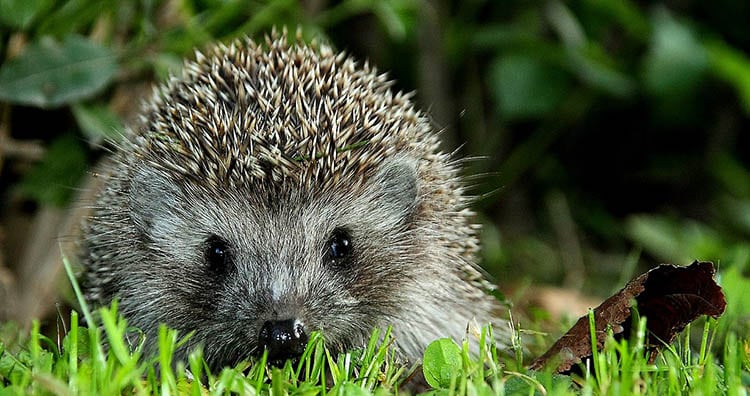
Mammals As Gastropod Predators
Many species of mammals are either carnivores or omnivores, for examples most wild species of hogs/pigs. Such animals, while not highly focused gastropod predators, will happily consume snails as a part of their highly varied diet.
Primates
While we human beings (Homo sapiens), well some of us, prefer our snails cooked with plenty of garlic and butter, other mammals are happy to consume them raw. Various monkeys such as Capuchins and Vervet Monkeys, species that are omnivorous but primarily fruit and or leaf eaters, will eat snails (as well as insects) whenever they find them. Baboons are also happy to enjoy a snail snack and Chimpanzees from DCR like to eat Giant African Land Snails, whose shells they crack open with rocks.
However, Chimpanzees (and humans) are not the only mammals to use tools to get at their favourite snail delicacies. Long-tailed macaques (Macaca fascicularis) on several islands in southern Thailand have acquired the habit of breaking open the shells of coastal snails and oysters to get at the meat inside. They’ve become such proficient shellfish hunters that they are actually threatening the existence of the oysters and snails an the small islands where they live.
Non-primate Mammals.
Among the many medium-sized carnivorous and omnivorous mammals many regularly include snails in their diets. Possums and opossums, skunks and raccoons, badgers, foxes, martens and mongooses all include snails in their diet, however none of them specialize in snails.
Many of the smaller mammalian carnivores will also seek out and devous snails. These include shrews such as the northern short-tailed shrew (Blarina brevicauda) and American shrew mole (Neurotrichus gibbsii) as well The Coast Mole (Scapanus orarius) and hedgehogs such the Western European Hedgehog (Erinaceus europaeus) and The Southern White-breasted Hedgehog (Erinaceus concolor) voraciously hunt live snails.
Finally various species of rats and mice are also avid gastropod predators and will eat snails whenever they get the opportunity. Rats have followed humanity around the world. Over the last five hundred years they have reached nearly every isolated island around the globe. Numerous species extinctions are believed to have been caused, or abetted, by these voracious omnivores including a number of species of snail.
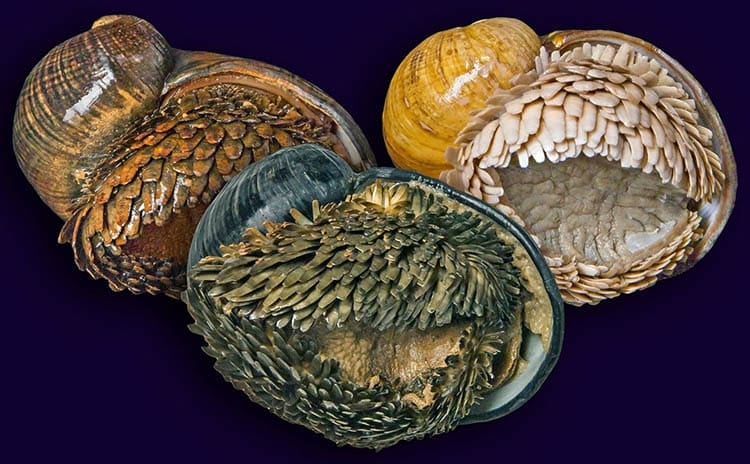
How Do Gastropods Defend Themselves?
With so many gastropod predators around, all eagerly looking for a snail dinner how do snails survive at all?
The most obvious defense that snails have is of course their shells. While the shells of terrestrial species are often relatively light weight, because they fee the full effects of gravity, those of marine species often heavily armoured and adorned with protective spikes and ridges. Many fresh water species also have an operculum, a horny structure that can be used to seal the opening of the shell. Other forms of defense include active evasion and passive hiding.
A Most Amazing Gastropod Defence
One of the most impressive examples of defence evolution can be seen in the Scaly-foot Snail (Chrysomallon squamiferum), also known as the Pangolin Snail. This rare and unique gastropod has a three-layered shell, rather than the usual two layered shell. The extra, and outer, layer is substance composed mostly of iron-sulphide. It also has scales over its foot of the same material. The main gastropod predators in the habitat are snail eating crabs, cone shells and Turrid gastropods.
C. squarmiferum is the only know animal in the world to use iron sulphide to produce armour. This amazing snail is also unusual for having a very large heart, 4% of its body mass and because it is a chemoautotroph. As a chemoautotroph it derives all its nutrition (at least as an adult) from endosymbioitic bacteria. Scaly-foot snails can be found around hydrothermal vents in the Indian Ocean, three different colour forms are known from three different localities.
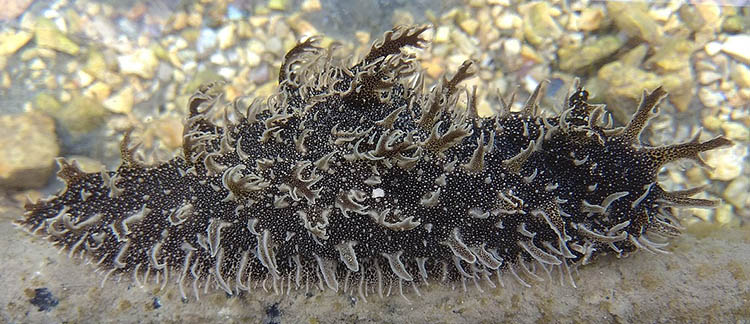
Defence in Marine Species
For marine species passive hiding involves cryptic colouration as well as choosing to spend the daylight ours hidden beneath rocks, detritus and fallen wood. Active evasion includes limpets and marine snails leaving a tidal pool when a starfish is placed in it. More rapid escape movements such as flipping themselves over and burrowing deeper into the substrate on sensing a predator are seen in some species. Much like their terrestrial cousins some marine snails go in for defensive mucous. Secreting a mucous that includes a cocktail of chemicals designed to repel predators.
Many marine species seem highly sensitized to chemical indicators that specific predators are near. In some experiments simply allowing water to drip off a predatory starfish into a tidal pool was sufficient to stimulate evasive in the snails and limpets in the pool. One unusual snail response to starfish predation is seen in the littoral marine snails of the genus Natica. They draw their mantel over their shell on being touched by one of the tube feet of the starfish Asteria rubens. This makes it difficult for the starfishes tube feet to grasp hold of the snail.
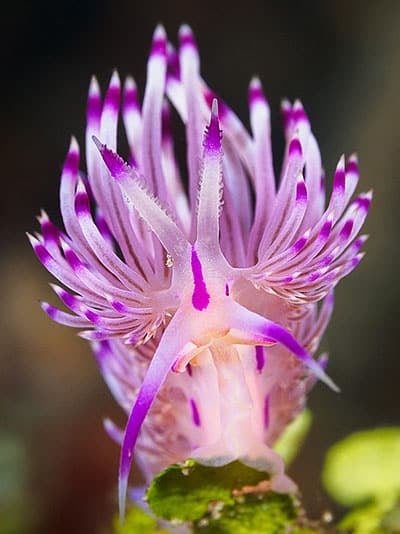
Nudibranchs, Reusing your Dinner’s Defences
Many nudibranchs feed on species of stinging animals such as anemones and hydroids. These animals which are part of phylum Cnidaria which have evolved specialized stinging cells to catch their own prey as well as to defend themselves. When a nudibranch, such as Coryphellina rubrolineata eats such an animal, its digestive system cleverly separates out the stinging cells without triggering them, then stores them in tentacles on its back (these are called cerata). Now the stinging nematocysts are under new management and anything that attacks the nudibranch then gets stung by those stolen weapons.
Chemical Warfare Under The Waves
Many nudibranchs and sea slugs are also independently toxic or have glands that can secrete noxious chemicals when disturbed. Sea slugs from the genus Elysia have white spots along their otherwise green bodies that act in this way.
Sea Hares, such as the Ragged Sea Hare, Bursatella leachii secrete a noxious mixture of viscous white opaline and purple dye when disturbed. These two chemicals are produced in separate glands and then mixed in the mantel cavity before being expelled.
Scientists have discovered that this adheres to the antennae of predators such as lobsters dulling their senses. Different species of Sea Hare produce different chemicals in their ink. The main active ingredient of the ink produced by the California Sea Hare Aplysia californica, an L-amino acid oxidase, has been delightfully named ‘escapin’ by scientists.
Defense Through Teamwork
Several species marine creatures including the Keyhole Limpet Diodora aspera form a commensal relationship with the Banded Scale Worm Arctonoe vittata. If the limpet is attacked by a starfish, such as Pisaster ochraceus, the scale worm defends its host by attacking the starfish, biting its tube feet. Apparently this is usually successful in driving the predator away. See this short video.
Defense in Terrestrial Species
For terrestrial species defenses against predators include cryptic coloration, defense mucus production including irritating smells and tastes; hiding behaviors, and rapid withdrawal and dislodging movements. Dislodging movements usually involve sudden twisting motions of the body from side to side. Defensive mucus is particularly favoured by slugs, perhaps because they have no shells. Defense mucus from slugs most likely contains chemicals repellent to predators, while this has not been well studied in terrestrial gastropods it has been proven for marine snails.
Image Credits:- Limpkin by HblairH, Ragged Sea Hare by Sarah Faulwetter – License CC BY-SA 4.0; Scaly-foot Snail by Chong Chen, Hedgehog by Tomaž Demšar – License CC BY-SA 3.0; Cover image by Heinz Albers – License CC BY 2.5; Horn Shark by Ed Bierman, Coryphellina rubrolineata by Christian Gloor – License CC BY 2.0; Asian Open-billed Stork by Shanmugam Saravanan – License CC0 1.0

